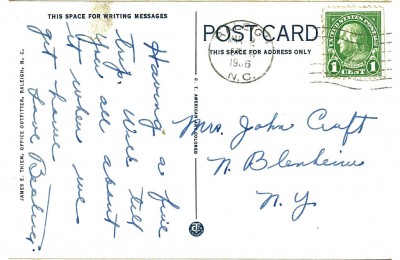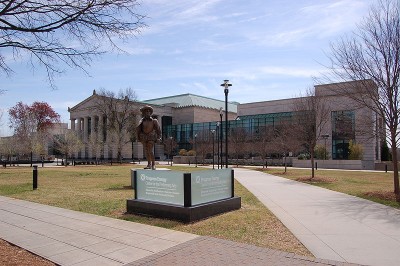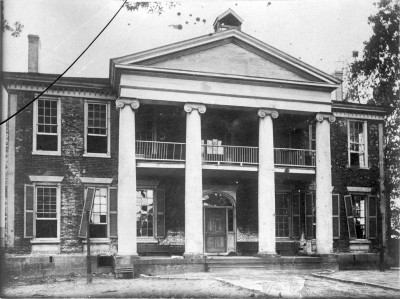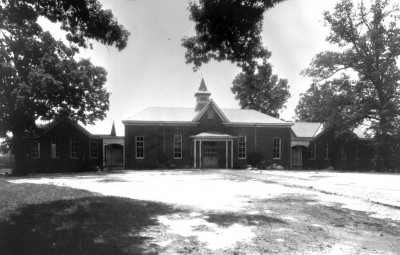Raleigh Memorial Auditorium, Raleigh, N.C., Seating Capacity 3,800
This week’s Flashback Friday postcard features Raleigh’s iconic Memorial Auditorium. The monumental building was erected in 1932 as a memorial to the soldiers who died during “The Great War” (WWI). Architecturally, it is a beautiful complement to our Greek Revival-styled State Capitol.
Having a fine trip. Will tell you all about it when we get home.
Love, Beatrice
Now, of course I wouldn’t know the itinerary of Beatrice and her husband’s ‘fine trip’, but judging from the recipient’s New York address, and the March 1936 postmark, I’d bet a dollar their end destination was probably Florida.
Raleigh Memorial Auditorium
The North Carolina architectural firm Atwood and Weeks designed Memorial Auditorium as the replacement for Raleigh’s City Auditorium, which had been destroyed by fire in 1930. The Neo-Classical Revival Fayetteville St. landmark was completed in 1932 with federal Works Progress Administration (WPA) funding. Raleigh builder and developer C.V. York was the contractor.
Raleigh Memorial Auditorium as it appeared in 1940.
Following various improvements and updates in 1963 and 1977, the auditorium underwent a major renovation in 1990 which featured an extension of the massive Doric portico, the addition of three performance halls and an external glass-enclosed concourse and lobby. Today the complex is home to the Progress Energy Center for the Performing Arts . It includes the Fletcher Opera Theater, the Kennedy Theater, and Meymandi Concert Hall, home of the North Carolina Symphony.
The Progress Energy Center for the Performing Arts is located at the foot of Fayetteville St. The statue of Sir Walter Raleigh has since been moved to the plaza in front of Raleigh’s Convention Center.
Raleigh Memorial Auditorium is listed on the National Register of Historic Places.
Historic Predecessors
Before the erection of Memorial Auditorium, its site at the foot of Fayetteville St. had been occupied by two earlier Raleigh landmarks — the ‘Governor’s Palace’ (1815) and the Centennial School (1876 and 1885).
The Governor’s Palace (above) was designed by James Calder of Washington, NC. The residence was remodeled in 1825 with a classical-styled portico added by William Nichols. Abandoned after the Civil War, the city acquired the property and established the Centennial School in the building in 1876.
In 1883 the aging palace building was demolished and a new Centennial School, designed by Samuel Sloan and A.G. Bauer, replaced it in 1885.
This week’s ‘white border’ postcard was published by long-time Raleigh stationer James Thiem, and was produced by the renowned Chicago postcard company Curt Teich Co.
Curt Teich Co.  1893-1974
Chicago, ILA major publisher and printer. Their U.S. factories turned out more cards in quantity than any other printer. They published a wide range of national view-cards of America and Canada. Many consider them one of the finest producers of White Border Cards. The Linen Type postcard came about through their innovations as they pioneered the use of offset lithography. They were purchased by Regensteiner Publishers in 1974 which continued to print cards at the Chicago plant until 1978.
“Flashback Friday†is a weekly feature of Goodnight, Raleigh! in which we showcase vintage postcards depicting our historic capital city. We hope you enjoy this week end treat!








 Sign up for the Newsletter
Sign up for the Newsletter
11/30/2012
Is that the Sir Walter Raleigh that was carved at North Hills Mall way back when? I remember the criticism of that statue was that his head was too big, or rather his feet were too small, and that seems to be the situation with this guy. I got a wood chip from North Hills Sir Walter, lost in transit decades ago.
Enloe held our 1969 graduation at Memorial Auditorium, and I went to see Peter, Paul & Mary there in the mid-60’s; the concert turned into an anti-war gathering.
Totally cool post. So much Raleigh history for many of us who were young a long, long time ago “in the last century.”
12/05/2012
HWG: the giant chain-saw carved wooden North Hills Sir Walter disappeared a LONG time ago. Dunno what happened to it.
The bronze Sir Walter was created by an Italian sculptor in the late 1970s (I think). Raleigh’s city fathers apparently never knew exactly what to do with it, as it migrated from its first location on the Bicentennial Mall to the Fayetteville St Mall, then disappeared for a decade or so until it landed on the lawn of the Progress Energy Center in the 1990s; finally it was moved to the new Raleigh Convention Center Plaza in 2006. And to think, Sir Walter himself never even made it to North Carolina.
12/06/2012
I think he also stood for several years at the end of New Bern Place.
12/11/2012
In the 1930s I went to many Civic Music concerts in tthe Memorial Auditorium, even sang a few times there with school choruses. My high school graduation ceremony was there in 1942.
01/07/2013
Evidently no elected official in North Carolina would go near the Governor’s Palace after it had been rudely occupied by the “Damn Yankees”, hence it’s abandonment after the Civil War. I wonder if there are to this day some “souvenir” fragments of Palace furnishings or fixtures mouldering in attics somewhere north of the Mason-Dixon line?
I thought the site had remained vacant after demolition of the Palace until Memorial Auditorium was built in 1932. Did not realize that a school stood there in its place for over 40 years…
07/03/2020
GEEZ, I feel such as you just study my mind! I have never seen any person think a way that matched my own in so many aspects.
https://edu-quotes.com/how-to-quote/how-to-put-a-quote-in-an-essay/ are usually also very proficient at
this, though. Nevertheless the internet is thus full of meaningless
text, I subscribed instantly not to miss any kind of updates.
09/29/2022
I think the statue of Sir Walter Raleigh that was carved at North Hills Mall is now in the City of Raleigh Museum in the old Briggs Hardware Building on Fayetteville Street.